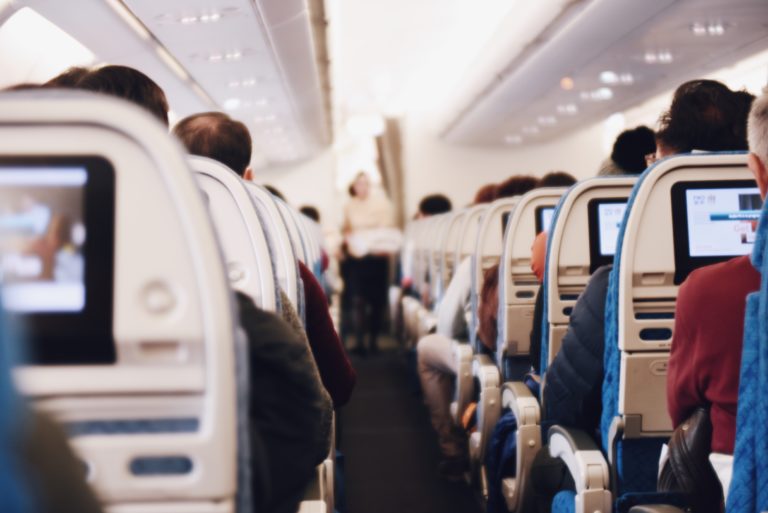Imagine this for a moment: You are trying to get comfortable in your too-small plane seat and possibly feeling a little claustrophobic. To add to this, flu droplets are being spluttered into the little bit of air around you, and your neighbour is apparently not familiar with the truism that to be truly sorry, one will not repeat the act.
As the plane is hoisted into the air, the air host lets out a thunderous sneeze. The toilet has been quietly occupied since boarding. This does not bode well for anyone’s health. The one thing they didn’t warn you about during the inflight safety demonstration was how to avoid and fight germs on the airplane.

It may be crowded with people, but you can still dodge the germs. Photo: Suhyeon Choi via Unsplash.
Contrary to popular belief, an airplane is not infested with more germs than any other public place. However, the concentration of people is higher because it is a confined space and as everyone is in there together for quite a while, your chances of catching a bug increase.
Remarkably, you are more likely to catch the sniffles or any other air-borne disease from the air host than from a passenger two rows ahead of you says a report by the Proceedings of the National Academy of Sciences. If you are two rows or more away from the sneezer, then you have only a 3% chance of catching their flu. Alas, if the person is seated right next to you, there is an 80% chance you will catch it.
The researchers went on to say that the air is drawn in from outside, circulated and filtered in a floor-to-ceiling direction. This means that passengers at the front don’t share air with passengers from the back, only their neighbours two seats next to them, in front of them or behind them. They also say that the air in a plane cabin is replaced 20 times an hour.
It may seem like whenever you step out of a plane you need to haul out the cold medication. Passengers are also more susceptible to airborne diseases during a flight because the humidity is lower than on the ground, which effects the mucus that protects your body from germs.
The air should not be your biggest concern, however, and nor should the unappealing toilets; according to TravelMath, tray tables are regarded as the dirtiest places on the plane, followed by the air vent dials above your seat and your seatbelt buckle. Avoid the seatback pocket too, because some people treat it as a bin. The aisle seat is where everyone walks past during the flight and rest their hand on the top of the seats for support, so this is the least sanitary seating choice.
While every flight is different based on the airline, the length of the trip, the number of passengers, and so on, it may be wise to keep wet wipes and hand sanitizer at the ready and to avoid touching your face.
As William Schaffmer, an infectious disease specialist at Vanderbilt University Medical Center told Tonic: “”We do know what we can do to avoid getting sick—wash your hands, get your annual flu vaccination, and cross your fingers.”
Some tips for staying healthy on a flight:
– Choose a window seat: this has less (germ-carrying) people walking past.
– Take wipes with you: wipe down any flat surface like the tray table, seatbelt buckle and arm rests.
– Drink water: stay hydrated by drinking water and not tea, coffee or alcohol. This will keep your skin and mucus linings in check.
– Keep moving: germs aren’t your only health enemy. Tap your feet while seated or move your toes up and down to keep your blood flowing to avoid blood clots.
– If you’re sick or have had surgery recently, be careful: the change in pressure may effect your heart and other organs.
Image:
You may also like
Related Posts
China’s National Health Commission has published a list of controversial coronavirus treatments that have animal...
read more
Warmer sea temperatures in the summer months, especially in February, were recorded and are believed...
read more
The latest report indexing the world's happiest countries has highlighted the important role of...
read more